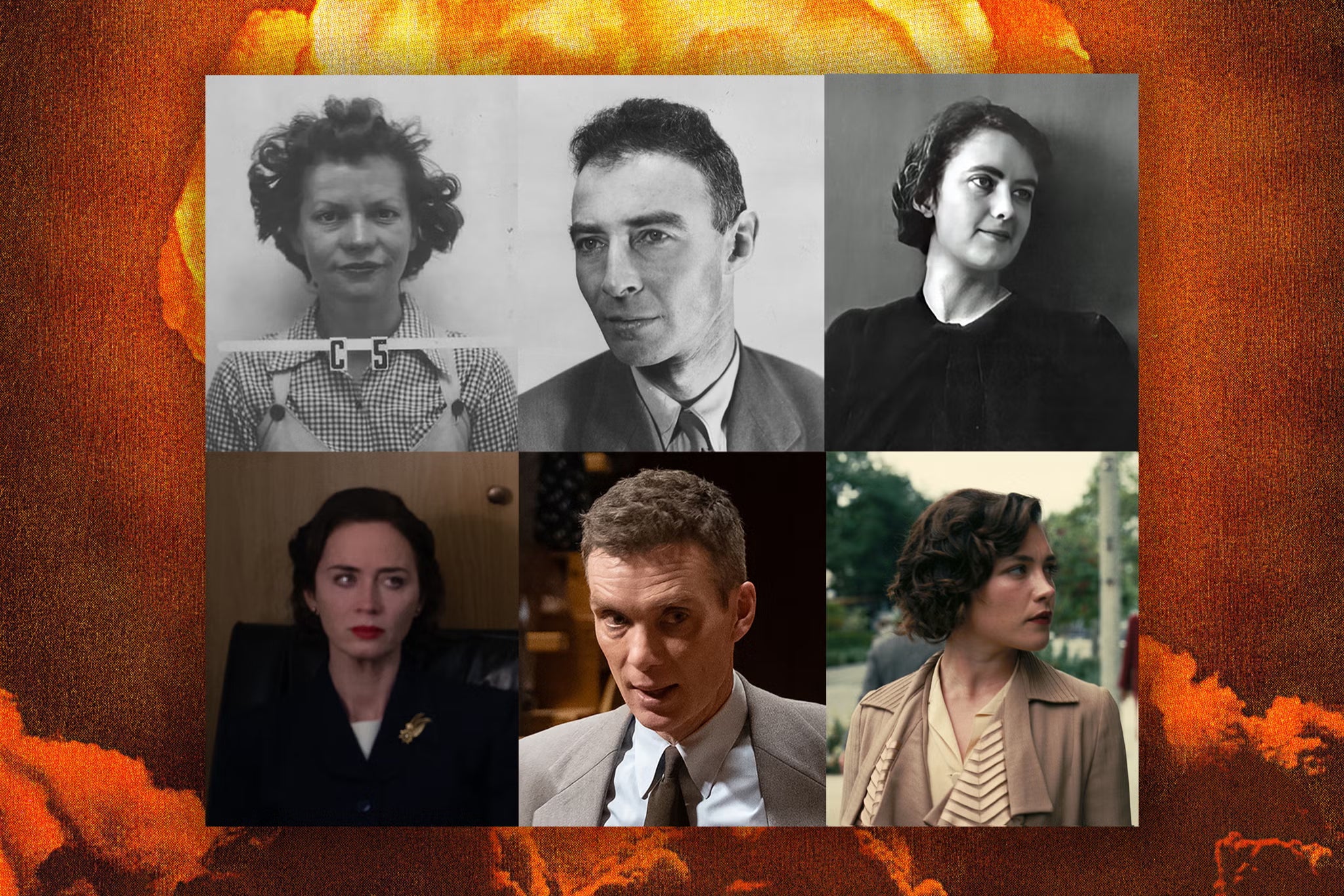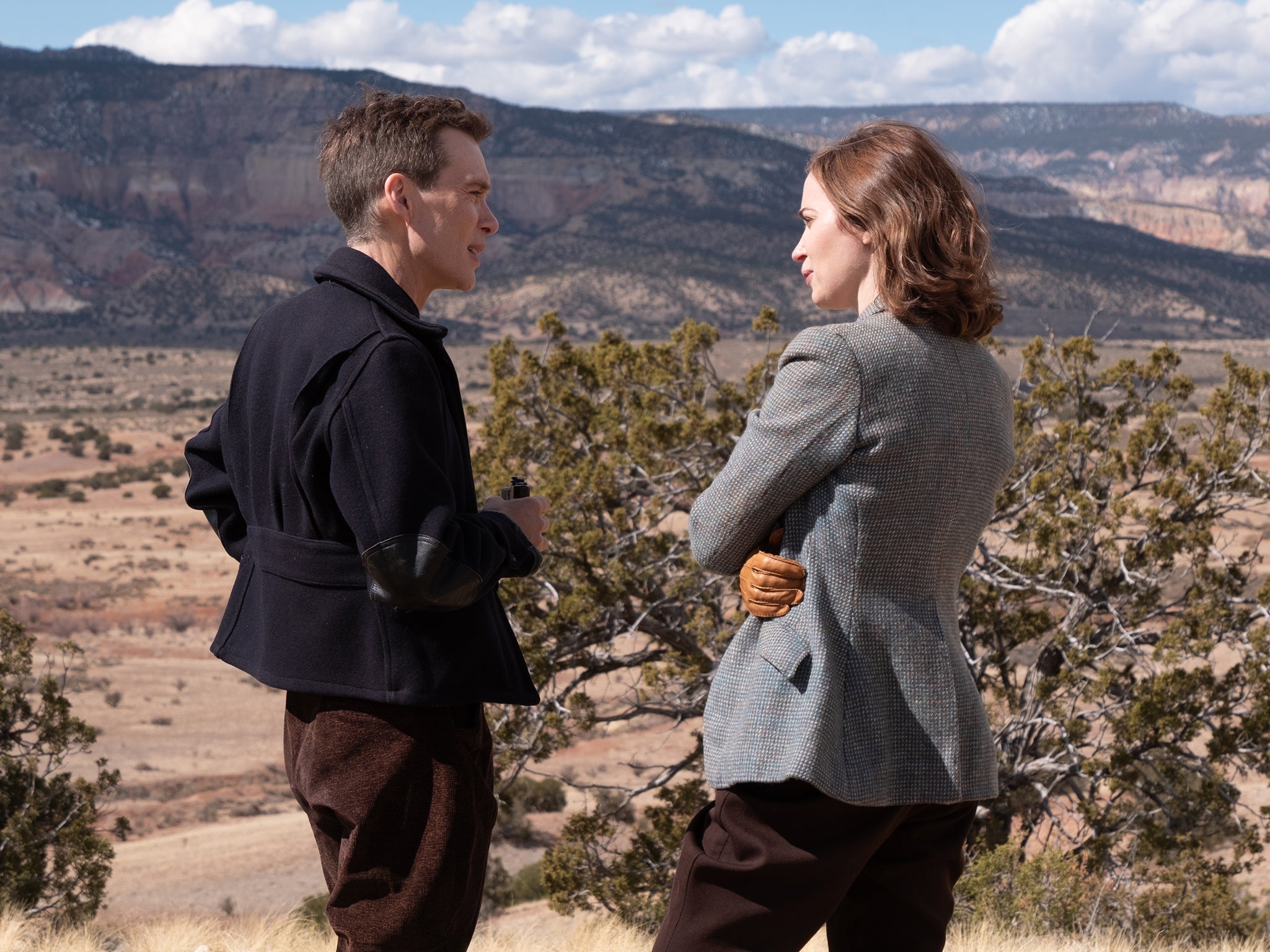Oppenheimer’s women: the true story of the brilliant, complicated female figures behind the famed physicist
In ‘Oppenheimer’, Christopher Nolan’s new film about the inventor of the atomic bomb, Florence Pugh is the messy mistress Jean Tatlock, Emily Blunt the alcoholic wife. Annabel Nugent talks to historians and discovers the women’s true story to be worthy of a three-hour film of its own


Your support helps us to tell the story
From reproductive rights to climate change to Big Tech, The Independent is on the ground when the story is developing. Whether it's investigating the financials of Elon Musk's pro-Trump PAC or producing our latest documentary, 'The A Word', which shines a light on the American women fighting for reproductive rights, we know how important it is to parse out the facts from the messaging.
At such a critical moment in US history, we need reporters on the ground. Your donation allows us to keep sending journalists to speak to both sides of the story.
The Independent is trusted by Americans across the entire political spectrum. And unlike many other quality news outlets, we choose not to lock Americans out of our reporting and analysis with paywalls. We believe quality journalism should be available to everyone, paid for by those who can afford it.
Your support makes all the difference.At 5.29am on 16 July, 1945: the first ever atomic bomb is detonated. Against the desert landscape of New Mexico, the device explodes with a power equivalent to 21,000 tons of dynamite, releasing a flare of light so bright researchers said it would have been visible from Mars. The code name for this world-changing, history-making test event? Trinity. The bomb’s creator, J Robert Oppenheimer, was said to have christened it thus as a tribute to the great love of his life and former mistress Jean Tatlock, with whom he shared a deep appreciation for John Donne’s poetry. “Batter my heart, three person’d God.”
It is a fascinating tidbit; one that speaks both to what kind of man Oppenheimer was and the influence that the women in his life undoubtedly had on him. And yet, this moment and others like it, do not make it into Christopher Nolan’s new biopic, Oppenheimer. The three-hour epic is a tremendous film, expectedly tense and superbly acted by Cillian Murphy, who wears the physicist’s signature porkpie hat and pipe as easily as his faraway gaze. Surrounding him are the many bespectacled scientists, buttoned-up politicians and gruff military personnel – all men – who played a pivotal part in his story. Largely absent, however, are the women of his life. A handful do appear – played by Florence Pugh, Emily Blunt and Louise Lombard – but their screen time is fleeting, and their importance is understated. The women of Oppenheimer are portrayed mostly as collateral damage, rather than what they were: an instrumental part of the story.
Tatlock – the supposed inspiration for Trinity, herself – appears early on. Played by Florence Pugh, the character is presented as being cut from the Sylvia Plath cloth: sexually liberated, fiercely intelligent, cool in manner, and deeply troubled. It’s true that, as the film portrays, Tatlock and Oppenheimer met at a Berkeley house party in the spring of 1936. She was 22; he was 10 years her senior. Born in Michigan, Tatlock came from a family of academics; her father, a Harvard-educated scholar, was an acclaimed English professor and an expert on Geoffrey Chaucer. Prior to attending Vassar College in 1931, Tatlock visited Europe, where she stayed with a friend in Switzerland who introduced her to the works of psychologist Carl Jung (her preference for Jung over Sigmund Freud is noted in Nolan’s film, moments before she and Oppenheimer have sex for the first time). Tatlock went on to study psychology herself, graduating from Vassar in 1935 before going on to study at Stanford School of Medicine. It was while completing prerequisite courses in Berkeley that she met Oppenheimer at that house party.
Over the years, much has been made of Tatlock’s political background – she was a dues-paying member of the Communist Party of the USA. Her relationship with Oppenheimer – seen as an indicator of Oppenheimer’s own political allegiances – was used as evidence against him in the security hearing of 1954, ultimately leading to the loss of his security clearance. But as Nolan’s film shows, communism was flourishing in those circles at the time. It’s likely that Oppenheimer would have explored the ideology with or without Tatlock; his brother and sister-in-law, plus many of his university colleagues, had belonged to the party at one point and opposed Franco in the Spanish Civil War. “Even Jean’s rather conservative father made donations to the ambulance corps,” Patricia Klaus and Shirley Streshinsky, authors of the 2013 biography An Atomic Love Story: The Extraordinary Women in Robert Oppenheimer’s Life, say over email. “I think that for Jean and Oppenheimer, their shared interest in psychology was a stronger bond. And from Jean, one of their friends would later say, Oppenheimer learnt to be compassionate.”
The film does depict that compassion, but also strongly suggests that there was a fervent sexual connection between the pair. In Nolan’s version, their characters are often seen if not in the throes of sex then straight after the act. It’s a portrayal that made Klaus uncomfortable. “Oppenheimer described Jean as a ‘lyrical, yearning creature’ and greatly admired her spirit and sensitivity,” she says. “I think from Kitty’s [Oppenheimer’s wife, whom he married in 1940] later comments – she said she had to teach him everything about sex, about how it could be ‘fun’ – and Jean’s reluctance to marry, this indicates that their physical relationship was not the most important part of their connection.” Oppenheimer proposed to Tatlock on two occasions; she declined both times.
By the time Oppenheimer had begun working on building the atomic bomb, he only saw Tatlock on rare occasions. They met one other for a final time in June of 1943 when Oppenheimer – by then, married to Kitty and serving as the director of Los Alamos, the site where he and his team developed the atomic bomb – visited her in a clandestine trip to San Francisco, where Tatlock was working as a paediatric psychiatrist at Mount Zion hospital and undergoing psychiatric treatment for her depression. (“Today, bipolar disorder might be suggested,” say Klaus and Streshinsky of Tatlock’s mental state at the time.)
Years later, at the Atomic Energy Commission hearing that revoked the security clearance of Oppenheimer in 1954, Oppenheimer recalled how Tatlock had called him to visit because “she was still in love with me”. As the film depicts, Kitty was in the room at the time of the hearing. It’s not clear what happened in that final meeting between Oppenheimer and Tatlock, but Nolan’s film suggests that it was there that Oppenheimer put an end to their affair once and for all. Whatever happened at that moment, Tatlock died by suicide seven months later. “For reasons of love and compassion, he had become a key member of Jean’s psychological support structure – and then he had vanished, mysteriously,” write Kai Bird and Martin J Sherwin write in their 2005 biography American Prometheus. “In Jean’s eyes, it may have seemed as if ambition had trumped love.”
As Nolan’s film shows, Tatlock’s romance with Oppenheimer overlapped with his marriage to Kitty, who is portrayed as ferocious (and mostly drunk) by Emily Blunt. Oppenheimer was married only once, but he was, in fact, Kitty’s third husband. Born Katherine Puening, the daughter of an engineer in Recklinghausen, Germany, she moved with her family to Pittsburgh, Pennsylvania when she was three years old. Later, Kitty dropped out of university and relocated to Paris, where she briefly attended the Sorbonne and the University of Grenoble. It was there where she met her first husband, a musician named Frank Ramsayer. The marriage was annulled only a few months later. That same year, after enrolling at the University of Wisconsin in 1933, she met Joseph Dallet, a communist organiser with whom she moved to Ohio. It was thanks to Dallet that Kitty found herself immersed in communism. When he left to fight in the Spanish Civil War, she wrote to him asking if she could join. Before she left for Europe, however, she learnt that Dallet had been killed in battle in 1937.

A year later, Kitty returned to college to study biology at the University of Pennsylvania. In 1939, she married Richard Harrison, a British doctor, and began pursuing graduate work in botany at UCLA. Around this time, she met Oppenheimer at a garden party. They began an affair. She visited his ranch in New Mexico, where they rode horses together. Kitty divorced Harrison in 1940 and married Oppenheimer the next day. They had a child, Peter, and moved to Los Alamos where Oppenheimer led the US efforts to make the first atomic bomb. There, Kitty briefly worked as a lab technician and also gave birth to their second child, a daughter named Katherine (known as Toni).

Watch Apple TV+ free for 7 days
New subscribers only. £8.99/mo. after free trial. Plan auto-renews until cancelled

Watch Apple TV+ free for 7 days
New subscribers only. £8.99/mo. after free trial. Plan auto-renews until cancelled
The site was home to colleagues and other families, many of whom took a strong dislike to Kitty. “And for good reason,” say Klaus and Streshinsky. “She took what she wanted, no matter what pain it might inflict on others. She could be a sharp and cruel person, especially to other women.” Between the isolation of new motherhood and that of Los Alamos, Kitty struggled with alcoholism – a focus, if not the focus, of her portrayal in the film. Speaking about her role, Blunt told The Washington Post, “The loneliness of life in Los Alamos must have just been extraordinary and I felt so deeply for this woman who was not a nice person and really rubbed people the wrong way.”
Despite their troubles, Kitty remained a close confidant of Oppenheimer’s, even when security protocols dictated otherwise. When the Trinity test went off successfully that July morning in 1945, Kitty was at home totally cut out of the action. Oppenheimer managed to get word to her, however, by sending her a prearranged secret message: “You can change the sheets.” The couple stayed together until Oppenheimer’s death in 1967, after which Kitty spread his ashes in front of their home in St John in the Virgin Islands. She later moved in with her long-time family friend Robert Serber, before she died in 1972 from a pulmonary embolism. She had been in Panama City, a stop on her round-the-world sailing trip.
Tatlock and Kitty were far from the only women in Oppenheimer’s life. “When we began our research we looked at all the women with whom Oppenheimer had relationships, some serious, some fleeting,” say Klaus and Streshinsky. “His mother, whom he adored; Jane Didisheim, a schoolmate; Katy Page, an older woman with whom he shared his love of New Mexico; Natalie Raymond, a friend through Ruth Tolman; Charlotte Houtermans whom he met at Göttingen; Ruth Tolman, his dearest friend.” In the film, we glimpse the importance of the latter: Ruth Tolman, played by a blonde and fabulous Louise Lombard.

Another psychologist, Ruth and her mathematician husband Richard had been friends of Oppenheimer since he arrived in California in 1928 at the age of 24. “Ruth and Robert were deep and close friends for decades,” Klaus and Streshinsky say. “He may have loved Kitty but on some level, he did not respect her; Ruth, he respected and admired. He relied on her for advice and the sort of comfort only a good friend can provide.” One of Oppenheimer’s secretaries claimed he always kept one of Tolman’s letters in his pocket.
Rumours of an affair between the two circulated – and are heavily hinted at in the film. In all their research, however, neither Klaus nor Streshinsky came across evidence to suggest their bond surpassed platonic. The writers say that the speculation was “most likely nasty gossip” spread by Oppenheimer’s peer, fellow physicist Ernest Lawrence who “with a long list of grievances – personal and professional – against Oppenheimer, relayed a rumour he had heard at a cocktail party that Ruth and Oppenheimer had been having an affair”. That Kitty, “a jealous person”, had never indicated any reason to suspect her husband’s friendship is another reason to disbelieve the rumours.
“Unfortunately, Lawrence’s accusation is brought up in the film, very briefly, but presented almost as fact, supported by quick clips of Ruth appearing as a woman likely to have an affair,” Klaus and Streshinsky say. “This does a disservice to Ruth and her relationship with Robert.”
Christopher Nolan famously doesn’t do women – or at least do them very well. Over the years, the British-American filmmaker has become known for many things: looping chronology, head-scratching plots, epic sets, an infuriatingly mercurial sound mix. Writing women has never been on that list. On Friday, as the clock ticked down to the release of Oppenheimer, not one person in the cinema had likely purchased their ticket believing that the film they were about to see would feature any prolonged insight into a woman’s mind. But while the omission is somewhat expected (and perhaps necessary given the film’s already lengthy runtime), it is a shame given how fascinating the women of this story are. What’s clear is that they could have filled an entire three-hour film of their own.



Join our commenting forum
Join thought-provoking conversations, follow other Independent readers and see their replies
Comments